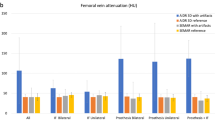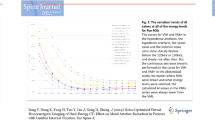Abstract
Purpose
To determine whether there is any additional metal artifact reduction when virtual monochromatic images (VMI) and metal artifact reduction for orthopedic implants (O-MAR) are applied together compared to their separate application in both phantom and clinical abdominopelvic CT studies.
Methods
An agar phantom containing a spinal prosthesis was scanned using a dual-layer, energy CT scanner (IQon, Philips Healthcare), and reconstructed with the filtered back-projection algorithm without O-MAR (FBP), filtered back-projection algorithm with O-MAR (O-MAR), VMI140 without O-MAR (VMI140), and VMI140 with O-MAR (VMI140 + O-MAR). Abdominopelvic CT images of 47 patients with metallic prostheses were also reconstructed in the same manner for clinical study. Noise measured as the standard deviation of CT Hounsfield units was compared between the four reconstruction methods in both phantom and clinical studies. Improvements in metal artifact reduction, image quality, and diagnostic improvement were further analyzed in the clinical study.
Results
Noise was significantly decreased when both VMI and O-MAR were applied in conjunction compared to their separate application in both phantom (16.3 HU vs. 25.0 and 26.4 HU) and clinical studies (15.8 HU vs. 19.2 and 26.2 HU). In the clinical study, the qualitative degree of artifacts was also significantly reduced with VMI140 + O-MAR (2.85 and 2.87) compared to VMI140 (2.36 and 2.26) or O-MAR (2.13 and 2.04) alone for both reviewers (P < 0.001) and improvements in image quality were observed in all 47 patients, with actual diagnostic improvements observed in three.
Conclusions
Metal artifacts can be additionally reduced by applying O-MAR and VMI in conjunction, compared to their separate application, thereby improving diagnostic performance.






Similar content being viewed by others
References
Bamberg F, Dierks A, Nikolaou K, et al. (2011) Metal artifact reduction by dual energy computed tomography using monoenergetic extrapolation. Eur Radiol 21(7):1424–1429
Barrett JF, Keat N (2004) Artifacts in CT: recognition and avoidance. Radiographics 24(6):1679–1691
Van Gompel G, Van Slambrouck K, Defrise M, et al. (2011) Iterative correction of beam hardening artifacts in CT. Med Phys 38(Suppl 1):S36
Mori I, Machida Y, Osanai M, Iinuma K (2013) Photon starvation artifacts of X-ray CT: their true cause and a solution. Radiol Phys Technol 6(1):130–141
Wang G, Vannier MW, Cheng PC (1999) Iterative X-ray cone-beam tomography for metal artifact reduction and local region reconstruction. Microsc Microanal 5(1):58–65
Wang G, Snyder DL, O’Sullivan JA, Vannier MW (1996) Iterative deblurring for CT metal artifact reduction. IEEE Trans Med Imaging 15(5):657–664
Kidoh M, Nakaura T, Nakamura S, et al. (2014) Reduction of dental metallic artefacts in CT: value of a newly developed algorithm for metal artefact reduction (O-MAR). Clin Radiol 69(1):e11–e16
Morsbach F, Wurnig M, Kunz DM, et al. (2013) Metal artefact reduction from dental hardware in carotid CT angiography using iterative reconstructions. Eur Radiol 23(10):2687–2694
Hsieh J, Molthen RC, Dawson CA, Johnson RH (2000) An iterative approach to the beam hardening correction in cone beam CT. Med Phys 27(1):23–29
Meinel FG, Bischoff B, Zhang Q, et al. (2012) Metal artifact reduction by dual-energy computed tomography using energetic extrapolation: a systematically optimized protocol. Invest Radiol 47(7):406–414
Yu L, Leng S, McCollough CH (2012) Dual-energy CT-based monochromatic imaging. AJR Am J Roentgenol 199(5 Suppl):S9–S15
Zhou C, Zhao YE, Luo S, et al. (2011) Monoenergetic imaging of dual-energy CT reduces artifacts from implanted metal orthopedic devices in patients with factures. Acad Radiol 18(10):1252–1257
Pessis E, Campagna R, Sverzut JM, et al. (2013) Virtual monochromatic spectral imaging with fast kilovoltage switching: reduction of metal artifacts at CT. Radiographics 33(2):573–583
An C, Chun YM, Kim S, et al. (2014) Dual-energy computed tomography arthrography of the shoulder joint using virtual monochromatic spectral imaging: optimal dose of contrast agent and monochromatic energy level. Korean J Radiol 15(6):746–756
Hu Y, Pan S, Zhao X, et al. (2017) Value and clinical application of orthopedic metal artifact reduction algorithm in CT scans after orthopedic metal implantation. Korean J Radiol 18(3):526–535
Shim E, Kang Y, Ahn JM, et al. (2017) Metal artifact reduction for orthopedic implants (O-MAR): usefulness in CT evaluation of reverse total shoulder arthroplasty. AJR Am J Roentgenol 209(4):860–866
Jeong S, Kim SH, Hwang EJ, et al. (2015) Usefulness of a metal artifact reduction algorithm for orthopedic implants in abdominal CT: phantom and clinical study results. AJR Am J Roentgenol 204(2):307–317
Huang JY, Kerns JR, Nute JL, et al. (2015) An evaluation of three commercially available metal artifact reduction methods for CT imaging. Phys Med Biol 60(3):1047–1067
Winklhofer S, Benninger E, Spross C, et al. (2014) CT metal artefact reduction for internal fixation of the proximal humerus: value of mono-energetic extrapolation from dual-energy and iterative reconstructions. Clin Radiol 69(5):e199–e206
Higashigaito K, Angst F, Runge VM, Alkadhi H, Donati OF (2015) Metal artifact reduction in pelvic computed tomography with hip prostheses: comparison of virtual monoenergetic extrapolations from dual-energy computed tomography and an iterative metal artifact reduction algorithm in a phantom study. Invest Radiol 50(12):828–834
Wang Y, Qian B, Li B, et al. (2013) Metal artifacts reduction using monochromatic images from spectral CT: evaluation of pedicle screws in patients with scoliosis. Eur J Radiol 82(8):e360–e366
Wilson JM, Christianson OI, Richard S, Samei E (2013) A methodology for image quality evaluation of advanced CT systems. Med Phys 40(3):031908
Philips Healthcare (2012) Metal artifact reduction for orthopedic implants (O-MAR). http://clinical.netforum.healthcare.philips.com/us_en/Explore/White-Papers/CT/Metal-Artifact-Reduction-for-Orthopedic-Implants-(O-MAR). Accessed 21 Feb 2018
Koehler T, Brendel B, Brown KM (2012) A new method for metal artifact reduction in CT. In: The International Conference in X-ray computed tomography. http://repository.tudelft.nl/assets/uuid:22d5815d-dcfe-48df-93a4-9d1c4e8e85fc/MS-33.229.pdf. Accessed 21 Feb 2018
Andersson KM, Nowik P, Persliden J, Thunberg P, Norrman E (2015) Metal artefact reduction in CT imaging of hip prostheses—an evaluation of commercial techniques provided by four vendors. Br J Radiol 88(1052):20140473
Andersson KM, Norrman E, Geijer H, et al. (2016) Visual grading evaluation of commercially available metal artefact reduction techniques in hip prosthesis computed tomography. Br J Radiol 89(1063):20150993
Han SC, Chung YE, Lee YH, et al. (2014) Metal artifact reduction software used with abdominopelvic dual-energy CT of patients with metal hip prostheses: assessment of image quality and clinical feasibility. AJR Am J Roentgenol 203(4):788–795
Matsumoto K, Jinzaki M, Tanami Y, et al. (2011) Virtual monochromatic spectral imaging with fast kilovoltage switching: improved image quality as compared with that obtained with conventional 120 kVp CT. Radiology 259(1):257–262
Brook OR, Gourtsoyianni S, Brook A, et al. (2013) Split-bolus spectral multidetector CT of the pancreas: assessment of radiation dose and tumor conspicuity. Radiology 269(1):139–148
Christner JA, Kofler JM, McCollough CH (2010) Estimating effective dose for CT using dose-length product compared with using organ doses: consequences of adopting International Commission on Radiological Protection publication 103 or dual-energy scanning. AJR Am J Roentgenol 194(4):881–889
Albert JM (2013) Radiation risk from CT: implications for cancer screening. AJR Am J Roentgenol 201(1):W81–W87
Author information
Authors and Affiliations
Corresponding author
Ethics declarations
Funding
This study was supported by Philips Health Systems Korea.
Conflict of interest
The authors declare that they have no conflict of interest.
Ethical approval
All procedures performed in studies involving human participants were in accordance with the ethical standards of the institutional and/or national research committee and with the 1964 Helsinki declaration and its later amendments or comparable ethical standards. For this type of study formal consent is not required.
Rights and permissions
About this article
Cite this article
Park, J., Kim, S.H. & Han, J.K. Combined application of virtual monoenergetic high keV images and the orthopedic metal artifact reduction algorithm (O-MAR): effect on image quality. Abdom Radiol 44, 756–765 (2019). https://doi.org/10.1007/s00261-018-1748-0
Published:
Issue Date:
DOI: https://doi.org/10.1007/s00261-018-1748-0




